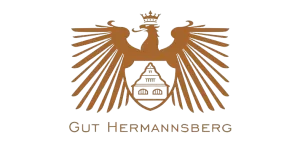Rough teenage years
In youth, they are often closed, dismissive and do not yet possess any balance. Only after a few years of aging - be it in the barrel, be it in the bottle - do they show what they are really made of. They begin to blossom when simple wines are already wilting. The fact that one can enjoy great Rieslings in perfect development is also a rare stroke of luck. Because the luxury behind it is time.
A great Riesling begins with ground work
Gut Hermannsberg on the Nahe is a pioneer when it comes to the luxury of "time". Cellarmaster Karsten Peter not only puts his heart and soul into vinification in the tradition-steeped cellar, but over the past twelve years he has also put a lot of work and time into the management and conversion of the seven VDP.Grossen Lagen, on which Gut Hermannsberg's vineyards extend. "If you want to produce a truly great Riesling," says Karsten Peter, "the work doesn't start after the harvest, but with pruning and even earlier: with soil cultivation. Ten years of work to produce perfect grapes is no exaggeration."
Paying attention to an infinite number of details
Today, Gut Hermannsberg does not use any chemical fertilizers, insecticides or herbicides. On 6 hectares we even work with the traditional hoe. In order to prevent erosion in the steep vineyards, which are up to 80% steep, straw is brought into the rows of vines every year. The yield of the vineyards today is about 25% below that of earlier years, but the wines have become extremely expressive again. The next stage is the processing in the cellar, where Gut Hermannsberg today works quite puristically with wild yeasts, completely avoiding finings, which supports strong characters. "When you have set these many small steps that lead to a great Riesling, it breaks your heart when the wine enters the glass too early," explains Achim Kirchner. "Too often you then have to experience that the whole dimension of the wine cannot be grasped." This was the reason why, back in 2015, Gut Hermannsberg set the release date for the estate's most renowned wine, Riesling Kupfergrube GG, at five years after the harvest.
Hermannsberg GG becomes a RESERVE wine
With the 2019 vintage, the switch to the Riesling Hermannsberg GG followed. Since 2016, partial quantities have already been set aside for the RESERVE concept, then from 2019 the entire harvest. The monopollage is eponymous for the winery. With its slate soils, the Hermannsberg shows particularly long closed and inaccessible, the development takes a similar time here as in the Kupfergrube, which have a completely different life curve there on volcanic soil. The Kupfergrube has to combine its expressive complexity into harmony, the Hermannsberg rather has to develop its talents. In the end, both sites benefit from the luxury of time. Trial by fire passed In a recent decade vertical tasting (together with Bâtard-Montrachet), one could see quite clearly how long the Hermannsberg needs to develop its balance and complexity. It was the Riesling Hermannsberg 2016 that wowed the experts, and it emerged as the clear winner of the tasting. It outshone all the younger vintages with elegance, precision and inner harmony. The conclusion made it clear that this wine is quite rightly only after five years on the market, because it is still at the beginning of its journey of development.
"It is only a few connoisseurs who recognize the great potential behind the sometimes almost dismissive nature of the wine. Hermannsberg has "hidden talents" that only reveal themselves with maturity. Then it becomes incredibly complex and deep. You miss the real greatness of this wine if you drink it too young," explains Karsten Peter.
Another VDP Grosses Gewächs will be released after a longer aging period: The Riesling von der Bastei will be allowed to age for two years.
Another time parameter: Old vines
In addition, only grapes from vines more than 30 years old are used for the GG wines. Younger vines are harvested for the local wines (Vom Vulkan / Vom Schiefer). And the youngest vines produce the grapes for the estate wine "7 Terroirs", which - as the name suggests - is harvested from the seven Grossen Lagen.
Based on the different sites and vine ages, the result is an impressive Riesling maturity pyramid, entirely dedicated to the expressiveness of the wines:
Hermannsberg | Einzellage GG | Fünf Jahre |
Kupfergrube | Einzellage GG | Fünf Jahre |
Bastei | Einzellage GG | Zwei Jahre |
Rotenberg | Einzellage GG | 12 Monate |
Steinberg | Einzellage GG | 12 Monate |
Felsenberg | Einzellage GG | 12 Monate |
Vom Vulkan | Ortswein | 8 Monate |
Vom Schiefer | Ortswein | 8 Monate |
7 Terroirs | Gutswein (aus sieben GG) | 8 Monate |
"We hope that with our philosophy of late releases we can contribute to an increased value of German Rieslings, both at home and abroad," explains Jasper Reidel, who has been on the winery's management team for three years. Gut Hermannsberg exports a good 50% of its Grosses Gewächse to 30 countries worldwide. "The reputation of German Riesling is elementary not only for us, but also for all our fellow winemakers who produce some of the best wines in the world in steep barren sites with great dedication and high risk."
Quotes on this topic:
"Riesling was my first love. Some of the ripest Rieslings I had the pleasure of tasting were over a century old and came from the Kloster Eberbach vineyards in the Rheingau and Gut Hermannsberg on the Nahe. One thing I can assure you of; acidity never dies, however sweetness becomes less evident." Marc Almert, ASI Best Sommelier of the World 2019. - "The Hermannsberg meets Bâtard Montrachet tasting clearly showed that Hermannsberg is now (again) one of the very great Rieslings of the Nahe." Sascha Speicher, Editor-in-Chief Meiningers Sommelier Magazin - "In recent weeks, Karsten Peter and his team have bottled an outstanding series of 2020s. It is the finest Riesling collection since the takeover. The winery's Rieslings have gained in finesse, precision and elegance." Stephan Reinhardt, Robert Parker Wine Advocate.







